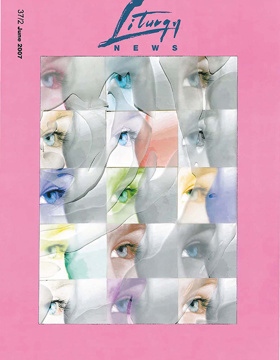Liturgy News
Vol 37 No 2 June 2007

Contents
| Title | Author | Topic | Page |
|---|---|---|---|
| Editor: The Liturgical Year in Australia | Elich, Tom | Seasons | 2 |
| Re-membering Sunday | Johnson, Clare | Sunday | 3-5 |
| The Church and Conversion: Communal Celebrations of Penance | O'Loughlin, Frank | Penance | 6-7 |
| Receive the Power | Catchlove, Paul | Music | 8 |
| Receive the Power | Pinto and Guy Sebastian, Gary | Children and Youth | 9 |
| Powerful Points for Liturgical Ministers | - | Ministries – Liturgical | 10 |
| Synod on the Word of God | - | Liturgy of the Word | 10 |
| Christian Unity | - | Baptism | 10 |
| Tridentine Mass | - | Texts – Liturgical | 10-11 |
| 'Limbo' Rocked | - | Baptism | 11 |
| Crackdown in Madrid | - | Liturgy | 11 |
| Patrick Murphy | - | In Memoriam | 12 |
| Missal Translation | - | Texts – Liturgical | 12 |
| Water Wisdon | Marshall, Erica | Symbols | 13 |
| Our Lady of Peace Chapel | Moran, Julie | Architecture and Environment | 14 |
| Books: Gather Faithfully, Laure L Krupp | Catchlove, Paul | Children and Youth | 15 |
| Student Art Competition: Melissa Williams | - | Art | 1, 16 |
Editorial
Editor: The Liturgical Year in Australia
Elich, Tom
The local organising committee of Societas Liturgica in Australia has been thinking about a suitable topic to recommend for the 2009 Congress to be held in Sydney. What area of study would be appropriate for the first Societas Liturgica gathering to be held in the southern hemisphere?
Time and place are intimately linked. When it is day here, it is night there; when it is summer there, it is winter here. Sun and moon, dawn and dusk, summer and winter, the arrangement of the stars, these patterns which mark the passage of time vary from north to south and from east to west and thus locate us in our particular place. The committee thought, therefore, that a perspective on liturgical time from our particular place would offer an interesting topic for the deliberations of Societas Liturgica.
In some ways the issues relating to the liturgical year may be more obvious to us in Australia than to many Europeans and north Americans. We are the ones who deal with all the Lent/Easter literature which interprets these events in terms of spring and the rebirth of nature after the death of winter. We experience the disjunction of locating Christmas at the winter solstice whilst we celebrate the liturgy in the full blaze of the summer sun. A reflection on the liturgical year from an Australian perspective would therefore suggest the need for inculturation, for interpreting the liturgical seasons in terms of the local culture of this place.
But how important is the seasonal setting of liturgical time? How important a perspective is 'place' when we think of the liturgical year? Are they an integral part of our understanding of the liturgical cycle or are they merely incidental? It is true that the natural seasons have contributed in a fundamental way to the shape and historical development of the pattern of the liturgical year. Do we need to respect these origins by, for example, maintaining notions of winter solstice even in midsummer, or even perhaps by adopting the more literal and crass, if generally playful, solution of celebrating 'Christmas in July? Or instead would we reinterpret the Christmas feast in terms of the 'fullness of light' of the summer solstice, providing a new framework of imagery for understanding the Christmas feast?
To go a step further, there is a sense in which 'sacred time' transcends chronological time or any specific place. The past events of our salvation created a new reality in which we now live and celebrate the joyful hope of their fulfilment From one point of view, the eternal reality of 'God's time' moves us utterly beyond any localisation or inculturation. The liturgical anamnesis gathers people of every time and place into the one saving action of Christ on the cross: ... you never cease to gather a people to yourself, so that from the rising of the sun to its setting, a pure oblation may be offered to your name (Eucharistic Prayer Ill). (Note: in a neat transfer from 'time' to 'place', our present translation uses 'from east to west'.)
On the other hand, 'between memory and hope', to use Robert Taft's phrase, is the concrete present. Precisely because the liturgical year makes the timeless events of our salvation a present reality, God's revelation has to be incarnate at a particular time in a particular place. We hear with our ears and see with our eyes. Christ is born for us in our midsummer world; Christ is risen in the context of our experience of refreshing coolness after the summer heat. Today, says Christ of his reading from Isaiah, this scripture has been fulfilled in your hearing (Lk 4:21). In the liturgy we proclaim, 'Today a Saviour has been born for us', Today is Christ risen from the dead', 'Today we have received the outpouring of the Holy Spirit'.
Our churches display clocks and calendars to mark the minutes and hours, starting times and finishing times, weeks, cycles of the moon, feast days and seasons. The instruments of time locate us at a particular place. And then the 'now' of the liturgical moment is caught up into the turning of the spheres, the universal seasons of cosmic praise, the fullness of time, the day of salvation.
Tom Elich
Editor
